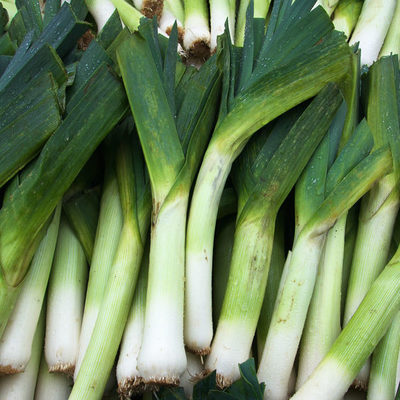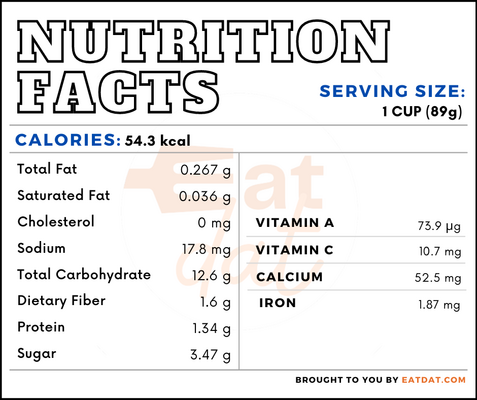
Leek
What is a Leek?
Leek is a crunchy and firm vegetable with a light onion-like taste. This plant is a member of the onion family. The edible parts of leek include light green parts and the white base of the leaves above the roots and stem base. The dark green parts are not usually eaten but are used when making stock soup. Leek is a very popular ingredient in various soups such as potato leek soup, colcannon soup, and leek vinaigrette.
- Commonly, leeks are roasted, boiled, or fried.
- Leeks are highly beneficial regardless of their low-calorie content. They have a lot of vitamins and minerals.
The biggest producers of Leek are Indonesia, France, Turkey, Belgium, and the Republic of Korea. Leek is usually cultivated from its seed. They can easily germinate in the same places that onions can grow. The soil needed to grow leek has to be well-drained and loose. The autumn months are the period when leeks usually ripen.
Leek history
The leek is a national symbol of the country Wales. The exact origin of Leeks is not known. However, they have been around for over 3000 years in Asia and Europe. Leeks are believed to come from the Mediterranean area and possibly Asia Minor. It was reported that Emperor Nero ate a lot of leeks prepared in oil. He thought this would improve his singing voice. Most people have the idea that Phoenician traders introduced leeks to Wales. Leeks were brought to the United States, Canada, and Australia due to the people who settled there first. Many people today still experiment and include leeks in their diet as much as possible.
Nutritional value
The nutritional value for one cup of leeks is:

Leeks do not have much calories. However, leeks are very rich in vitamins and other minerals. Below are some of the recognized health benefits of consuming leeks:
- They provide vitamin k1 for the body, which is good for heart health and blood clotting.
- Leeks serve as a good source of antioxidants, which is beneficial in fighting against cancer and diabetes.
- Leeks have anti-inflammatory properties which are capable of minimizing the risk of stroke.
- Leeks also promote weight loss as they are rich in water and fiber.
- Research has shown that leeks might be able to lower blood sugar levels and promote digestion.
Leek recipes
It’s possible to eat leeks by itself. However, this crunchy vegetable plays a big role as an ingredient in other foods. Here are ten recipes that include leeks.
- Spring Minestrone with Caramelized Garlic Broth
- Classic, Creamy Potato Leek Soup
- Asparagus, Prosciutto & Goat Cheese Frittata
- Braised Lentils and Leeks
- Ottolenghi’s Braised Eggs with Leek and Za’atar
- Jacques Pépin’s Rustic Leek and Potato Soup
- Crispy Ginger Rice with Leeks, Shiitakes, and a Fried Egg
- Sweet Corn Risotto
- Creamy Spring Vegetable Gratin with Grana Padano
- 30-Minute Leek Confit
Application
Leeks need to be cut into slices before they are used. Follow the steps below to cut Leeks.
- Place the vegetable on a flat cutting surface.
- Use a sharp knife to slice off a thin part of the root part.
- Remove the dark green parts and keep them only if you will need them later.
- Cut off any wilted leaves as well.
- Then cut the tender parts into slices according to your preference.
- Please place them in a draining bowl and rinse in flowing tap water.
The best place to store Leeks is in the crisper drawer of your refrigerator. They can stay up to two weeks in the fridge, depending on their freshness level. Before doing so, do well to place them in a plastic wrap. This is because the aroma from them can affect other food items in your refrigerator. It’s best not to trim fresh leeks before storing them. It is also advisable to refrigerate and use cooked leeks with one or two days. It’s not a good idea to freeze leeks except if you’d want to use them in soups. Freezing can make them mushy and taste bitter. Cut them into slices and place in airtight bags if you intend to freeze. Ensure you use them in three months.
When you buy leeks, take note of the following tips.
- Don’t buy leeks that have a yellow color.
- Choose the ones that are fresh and firm.
- Buy leeks that possess as much light green and white as possible.
FDA regulations
There is no specific FDA regulation that refers to leeks. However, the food and Drug Administration has its regulations concerning fruits and vegetables.
References
“Historical background of leeks”- https://www.cultures.ca/en-CA/leeks/origins-leeks
“How to clean leeks”- https://www.simplyrecipes.com/recipes/how_to_clean_leeks/
